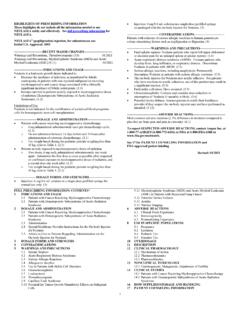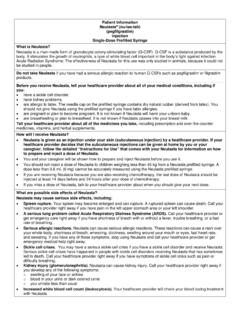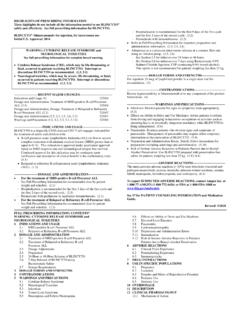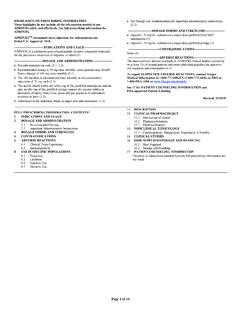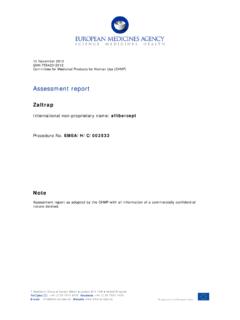Transcription of HIGHLIGHTS OF PRESCRIBING INFORMATION …
1 HIGHLIGHTS OF PRESCRIBING INFORMATION These HIGHLIGHTS do not include all the INFORMATION needed to use vectibix safely and effectively. See full PRESCRIBING INFORMATION for vectibix . vectibix ( panitumumab ) Injection for intravenous use Initial US Approval: 2006 WARNING: DERMATOLOGIC TOXICITY See full PRESCRIBING INFORMATION for complete boxed warning. Dermatologic toxicities were reported in 90% of patients and were severe in 15% of patients receiving monotherapy. ( , , ) ----------------------------RECENT MAJOR CHANGES-------------------------- Indications and Usage (1) 06/2017 Dosage and Administration (2) 06/2017 Warnings and Precautions (5) 06/2017 ----------------------------INDICATIONS AND USAGE--------------------------- vectibix is an epidermal growth factor receptor (EGFR) antagonist indicated for the treatment of wild-type RAS (defined as wild-type in both KRAS and NRAS as determined by an FDA-approved test for this use) metastatic colorectal cancer (mCRC): In combination with FOLFOX for first-line treatment.
2 ( , ) As monotherapy following disease progression after prior treatment with fluoropyrimidine, oxaliplatin, and irinotecan-containing chemotherapy. ( , ) Limitation of Use: vectibix is not indicated for the treatment of patients with RAS-mutant mCRC or for whom RAS mutation status is unknown. ( , , , ) ----------------------DOSAGE AND ADMINISTRATION----------------------- Administer 6 mg/kg every 14 days as an intravenous infusion over 60 minutes ( 1000 mg) or 90 minutes (> 1000 mg). (2) Infusion Reactions: Reduce infusion rate by 50% for mild reactions; terminate the infusion for severe infusion reactions. ( , ) Dermatologic Toxicity: Withhold or discontinue for severe or intolerable toxicity; reduce dose for recurrent, grade 3 toxicity. ( , ) ---------------------DOSAGE FORMS AND STRENGTHS---------------------- Injection: 100 mg/5 mL (20 mg/mL) and 400 mg/20 mL (20 mg/mL) in single-dose vials.
3 (3) -------------------------------CONTRAIND ICATIONS------------------------------ None -----------------------WARNINGS AND PRECAUTIONS------------------------ Dermatologic and Soft Tissue Toxicity: Monitor for dermatologic and soft tissue toxicities and withhold or discontinue vectibix for severe or life-threatening complications. Limit sun exposure. ( , ) Increased tumor progression, increased mortality, or lack of benefit in patients with RAS-mutant mCRC. ( , ) Electrolyte Depletion/Monitoring: Monitor electrolytes and institute appropriate treatment. ( ) Infusion Reactions: Terminate the infusion for severe infusion reactions. ( ) Pulmonary Fibrosis/Interstitial Lung Disease (ILD): Permanently discontinue vectibix in patients developing ILD. ( ) Ocular Toxicities: Monitor for keratitis or ulcerative keratitis.
4 Interrupt or discontinue vectibix for acute or worsening keratitis. ( ) Embryo-fetal Toxicity: Can cause fetal harm. Advise females of reproductive potential of the potential risk to the fetus and to use effective contraception during treatment with vectibix and for 2 months after the last dose. ( , , ) ------------------------------ADVERSE REACTIONS------------------------------- Most common adverse reactions ( 20%) of vectibix as monotherapy are skin rash with variable presentations, paronychia, fatigue, nausea, and diarrhea. ( ) Most common adverse reactions ( 20%) in clinical trials of vectibix in combination with FOLFOX chemotherapy are diarrhea, stomatitis, mucosal inflammation, asthenia, paronychia, anorexia, hypomagnesemia, hypokalemia, rash, acneiform dermatitis, pruritus, and dry skin.
5 ( ) To report SUSPECTED ADVERSE REACTIONS, contact Amgen Inc. at 1-800-77-AMGEN (1-800-772-6436) or FDA at 1-800-FDA-1088 or ------------------------ USE IN SPECIFIC POPULATIONS --------------------- Lactation: Advise women not to breastfeed. ( ) See 17 for PATIENT COUNSELING INFORMATION Revised: 06/2017 _____ FULL PRESCRIBING INFORMATION : CONTENTS* WARNING: DERMATOLOGIC TOXICITY 1 INDICATIONS AND USAGE Metastatic Colorectal Cancer 2 DOSAGE AND ADMINISTRATION Patient Selection Recommended Dose Dose Modifications Preparation and Administration 3 DOSAGE FORMS AND STRENGTHS 4 CONTRAINDICATIONS 5 WARNINGS AND PRECAUTIONS Dermatologic and Soft Tissue Toxicity Increased Tumor Progression, Increased Mortality, or Lack of Benefit in Patients with RAS-Mutant mCRC Electrolyte Depletion/Monitoring Infusion Reactions Acute Renal Failure in Combination with Chemotherapy Pulmonary Fibrosis/Interstitial Lung Disease (ILD)
6 Photosensitivity Ocular Toxicities Increased Mortality and Toxicity with vectibix in Combination with Bevacizumab and Chemotherapy Embryo-fetal Toxicity 6 ADVERSE REACTIONS Clinical Trials Experience Immunogenicity Postmarketing Experience 8 USE IN SPECIFIC POPULATIONS Pregnancy Lactation Females and Males of Reproductive Potential Pediatric Use Geriatric Use 10 OVERDOSAGE 11 DESCRIPTION 12 CLINICAL PHARMACOLOGY Mechanism of Action Pharmacokinetics 13 NONCLINICAL TOXICOLOGY Carcinogenesis, Mutagenesis, Impairment of Fertility 14 CLINICAL STUDIES Recurrent or Refractory mCRC First-line in Combination with FOLFOX Chemotherapy RAS-Mutant mCRC 16 HOW SUPPLIED/STORAGE AND HANDLING 17 PATIENT COUNSELING INFORMATION *Sections or subsections omitted from the full PRESCRIBING INFORMATION are not listed_____ FULL PRESCRIBING INFORMATION WARNING: DERMATOLOGIC TOXICITY Dermatologic Toxicity: Dermatologic toxicities occurred in 90% of patients and were severe (NCI-CTC grade 3 and higher) in 15% of patients receiving vectibix monotherapy [see Dosage and Administration ( ), Warnings and Precautions ( ), and Adverse Reactions ( )].
7 1 INDICATIONS AND USAGE Metastatic Colorectal Cancer vectibix is indicated for the treatment of patients with wild-type RAS (defined as wild-type in both KRAS and NRAS as determined by an FDA-approved test for this use) metastatic colorectal cancer (mCRC) [see Dosage and Administration ( )]: As first-line therapy in combination with FOLFOX [see Clinical Studies ( )]. As monotherapy following disease progression after prior treatment with fluoropyrimidine-, oxaliplatin-, and irinotecan-containing chemotherapy [see Clinical Studies ( )]. Limitation of Use: vectibix is not indicated for the treatment of patients with RAS-mutant mCRC or for whom RAS mutation status is unknown [see Dosage and Administration ( ), Warnings and Precautions ( ), and Clinical Pharmacology ( )]. 2 DOSAGE AND ADMINISTRATION Patient Selection Prior to initiation of treatment with vectibix , assess RAS mutational status in colorectal tumors and confirm the absence of a RAS mutation in exon 2 (codons 12 and 13), exon 3 (codons 59 and 61), and exon 4 (codons 117 and 146) of both KRAS and NRAS.
8 INFORMATION on FDA-approved tests for the detection of RAS mutations in patients with metastatic colorectal cancer is available at: Recommended Dose The recommended dose of vectibix is 6 mg/kg, administered as an intravenous infusion over 60 minutes, every 14 days. If the first infusion is tolerated, administer subsequent infusions over 30 to 60 minutes. Administer doses higher than 1000 mg over 90 minutes [see Dosage and Administration ( )]. Appropriate medical resources for the treatment of severe infusion reactions should be available during vectibix infusions [see Warnings and Precautions ( )]. Dose Modifications Dose Modifications for Infusion Reactions [see Warnings and Precautions ( ) and Adverse Reactions ( , )] Reduce infusion rate by 50% in patients experiencing a mild or moderate (grade 1 or 2) infusion reaction for the duration of that infusion.
9 Terminate the infusion in patients experiencing severe infusion reactions. Depending on the severity and/or persistence of the reaction, permanently discontinue vectibix . Dose Modifications for Dermatologic Toxicity [see Boxed Warning, Warnings and Precautions ( ), and Adverse Reactions ( , )] Upon first occurrence of a grade 3 (NCI-CTC/CTCAE) dermatologic reaction, withhold 1 to 2 doses of vectibix . If the reaction improves to < grade 3, reinitiate vectibix at the original dose. Upon the second occurrence of a grade 3 (NCI-CTC/CTCAE) dermatologic reaction, withhold 1 to 2 doses of vectibix . If the reaction improves to < grade 3, reinitiate vectibix at 80% of the original dose. Upon the third occurrence of a grade 3 (NCI-CTC/CTCAE) dermatologic reaction, withhold 1 to 2 doses of vectibix .
10 If the reaction improves to < grade 3, reinitiate vectibix at 60% of the original dose. Upon the fourth occurrence of a grade 3 (NCI-CTC/CTCAE) dermatologic reaction, permanently discontinue vectibix . Permanently discontinue vectibix following the occurrence of a grade 4 dermatologic reaction or for a grade 3 (NCI-CTC/CTCAE) dermatologic reaction that does not recover after withholding 1 or 2 doses. Preparation and Administration For intravenous infusion only. Do not administer vectibix as an intravenous push or bolus. Preparation Visually inspect parenteral drug products for particulate matter and discoloration prior to administration. vectibix solution is colorless and may contain a small amount of visible translucent-to-white, amorphous, proteinaceous particles. Do not use if the solution is discolored or cloudy, or if foreign matter is present.
